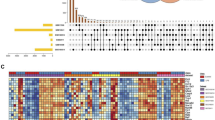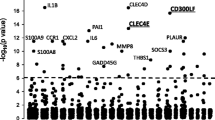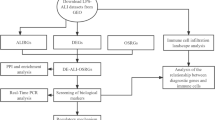Summary
In order to provide us new clues to induce some endogenous protective molecular mechanisms, the changes in gene expression profile induced by ischemia-reperfusion in pulmonary tissues of rats were investigated and the dynamic mechanism of pulmonary ischemia-reperfusion injury was elucidated. Thirty male Wistar rats were randomly divided into 6 groups: 5 ischemia-reperfusion (I/R) groups (I/R 0-h, I/R 1-h, I/R 3-h, I/R 6-h, I/R 24-h) and control group (n=5 in each). An in situ ischemia-reperfusion lung injury rat model was established by occluded hilus of lung. The RatRef-12 Expression Beadchip (22 226 gene probes per array) was used to analyze the pattern of gene expression in all groups. The results showed that 648, 340, 711, 1279 and 641 genes were differentially expressed in I/R 0-, 1-, 3-, 6-and 24-h groups respectively. The differentially expressed genes were classified as following 7 functional categories: cytokine, adhesion molecule, growth factor and apoptosis-related factor, oxidation and antioxidation molecule, metabolic enzyme, ion channel and aquaporin, signal transduction molecule. It was suggested that gene chip technology was an effective and quick method for screening differentially expressed genes. Many differentially expressed genes with different functions interacted each other to result in pulmonary ischemia-reperfusion injury.
Similar content being viewed by others
References
Patterson G A. Indications. Unilateral, bilateral, heart-lung, and lobar transplant procedures. Clin Chest Med, 1997,18(2):225–230
Fiser S M, Tribble C G, Long S M et al. Ischemia-reperfusion injury after lung transplantation increases risk of late bronchiolitis obliterans syndrome. Ann Thorac Surg, 2002,73:1041–1047
Eppinger M J, Deeb G M, Bolling S F et al. Mediators of ischemia-reperfusion injury of rat lung. Am J Pathol, 1997,150(5):1773–1784
Tomasdottir H, Hjartarson H, Ricksten A et al. Tumor necrosis factor gene polymorphism is associated with enhanced systemic inflammatory response and increased cardiopulmonary morbidity after cardiac surgery. Anesth Analg, 2003,97(4):944–949
Kwon O J, Au B T, Collins P D et al. Tumor necrosis factor-induced interleukin-8 expression in cultured human airway epithelial cells. Am J Physiol, 1994,267(4 Pt 1):L398–L405
Sekido N, Mukaida N, Harada A et al. Prevention of lung reperfusion injury in rabbits by a monoclonal antibody against interleukin-8. Nature, 1993, 365:654–657
Fiser S M, Tribble C G, Long S M et al. Lung transplant reperfusion injury involves pulmonary macrophages and circulating leukocytes in a biphasic response. J Thorac Cardiovasc Surg, 2001,121:1069–1075
de Perrot M, Young K, Imai Y et al. Recipient T cells mediate reperfusion injury after lung transplantation in the rat. J Immunol, 2003,171:4995–5002
Zwacka R M, Zhang Y, Halldorson J et al. CD4+ T-lymphocytes mediate ischemia/reperfusion-induced inflammatory responses in mouse liver. J Clin Invest, 1997,100:279–289
Hosenpud J D, Bennett L E, Keck B M et al. The Registry of the International Society for Heart and Lung Transplantation: seventeenth official report: 2000. J Heart Lung Transplant, 2000,19:909–931
Fischer S, Liu M, Maclean A A et al. In vivo transtracheal adenovirus-mediated transfer of human interleukin-10 gene to donor lungs ameliorates ischemia-reperfusion injury and improves early posttransplant graft function in the rat. Hum Gene The, 2001,12:1513–1526
Otterbein L E, Choi A M. Heme oxygenase: colors of defense against cellular stress. Am J Physiol Lung Cell Mol Physiol, 2000,279:L1029–L1037
Clark J E, Foresti R, Sarathchandra P et al. Heme oxygenase-1-derived bilirubin ameliorates postischemic myocardial dysfunction. Am J Physiol Heart Circ Physiol, 2000,278:H643–H651
Otterbein L E, Bach F H, Alam J et al. Carbon monoxide has anti-inflammatory effects involving the mitogen-activated protein kinase pathway. Nat Med, 2000,6:422–428
Courtade M, Carrera G, Paternain J L et al. Metallothionein expression in human lung and its varying levels after lung transplantation. Toulouse Lung Transplantation Group. Chest, 1998,113:371–378
Wang G W, Zhou Z, Klein J B et al. Inhibition of hypoxia/reoxygenation-induced apoptosis in metallothionein-overexpressing cardiomyocytes. Am J Physiol Heart Circ Physiol, 2001,280:H2292–H2299
Li X, Chen H, Epstein P N. Metallothionein protects islets from hypoxia and extends islet graft survival by scavenging most kinds of reactive oxygen species. J Biol Chem, 2004,279:765–771
Tsung A, Sahai R, Tanaka H et al. The nuclear factor HMGB1 mediates hepatic injury after murine liver ischemia/reperfusion. J Exp Med, 2005,201:1135–1143
Wu H S, Zhang J X, Wang L et al. Toll-like receptor 4 involvement in hepatic ischemia/reperfusion injury in mice. HBPD INT, 2004,3:250–253
Oyama J, Blais C Jr, Liu X et al. Reduced myocardial ischemia-reperfusion injury in toll-like receptor 4-deficient mice. Circulation, 2004,109:784–789
Liu M. Searching for ARDS genes: aren’t we there yet? Am J Respir Crit Care Med, 2005,171:298–299
Author information
Authors and Affiliations
Corresponding author
Rights and permissions
About this article
Cite this article
Li, J., Nie, J., Chen, G. et al. Gene expression profile of pulmonary tissues in different phases of lung ischemia-reperfusion injury in rats. J. Huazhong Univ. Sci. Technol. [Med. Sci.] 27, 564–570 (2007). https://doi.org/10.1007/s11596-007-0523-1
Received:
Issue Date:
DOI: https://doi.org/10.1007/s11596-007-0523-1




